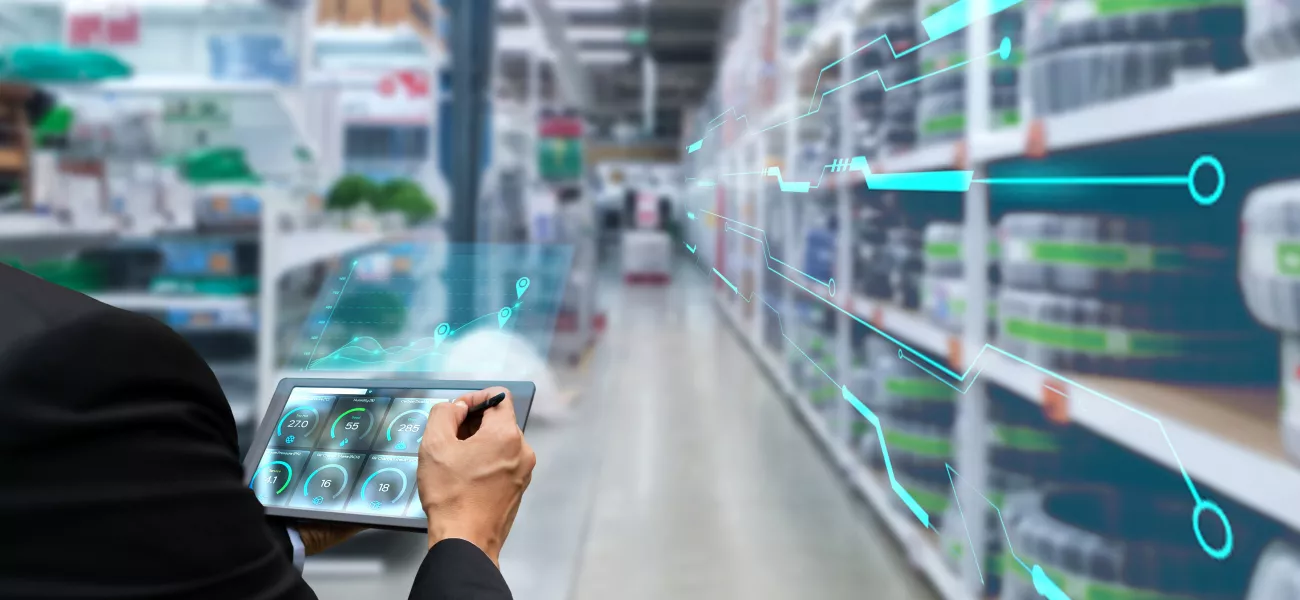
Imagine turning every corner of your retail space into a data-driven touchpoint. What if your existing cameras could tell you when customers are ready to buy, which products they are considering, and even predict stock shortages before they happen? The future is already here — where AI-powered analytics transform traditional surveillance into a smart engine for efficiency and revenue growth.
As consumer shopping habits change, the retail industry has continued to evolve and adapt to new needs and preferences. The ecommerce market is still performing well and is set to hit $11 trillion in 2028. A clear benefit of online shopping is that customer data can be gathered from interactions to gain insights into behaviors, enabling retailers to tailor consumer experiences and push relevant promotions to the right people.
However, this isn’t the only place where retailers can gain rich insights. Physical stores are increasingly using technology to not only enrich the in-store experience, but to gather data that has previously only been accessible through online shopping. This is where scene intelligence comes in. Computer vision and AI can add insights to visual imagery captured by surveillance cameras, equipping retailers with the information they need to understand customer behavior, enhance the customer experience and facilitate smooth business operations.
Many of these capabilities can be built into existing cameras, if the hardware and placement are suitable. This will help retailers unlock valuable business intelligence, boost efficiency and reduce TCO. Leveraging AI-powered computer vision is no longer only relevant to meeting security and safety objectives, but is now a powerful tool for optimizing operations through automation. This enables staff to focus on the customer, while also securing cost savings.
Let’s look at how this works in practice across five key zones in the customer’s journey throughout your store: the parking area, entrance, sales floor, merchandising display and POS/checkouts. We’ll examine how network solutions and analytics can optimize operational efficiency and improve the experience.
Optimizing every touch point, from parking lot to checkout
The customer journey often begins from the parking lot. This serves as a prime opportunity to deploy AI to help create a positive customer impression from the moment they enter the premises. While some customers will be heading to the main shop floor to browse, some may only be visiting the store for a short period of time, for instance, to collect an order already placed. This means there is a small window of time to impress them. However, if their order isn’t ready or is incorrect, this may lead to unnecessary wait times, undermining the value of the collection service and leading to unhappy customers.
Fortunately, AI can step in to facilitate the smooth delivery of this service. For instance, when a car arrives in your pickup area, AI-powered analytics can detect the car and alert staff. Next, a live or pre-recorded audio message is played through a speaker to notify the customer that a member of staff is on their way. In the meantime, targeted promotions can be shown to the customer while they are waiting in the car. This slick process means customers can swiftly exit with their items, increasing the likelihood of repeat orders.
Turning every entrance into a smart gateway
Moving on from the parking lot, the next location to discuss would be the store entrance. Though often overlooked by retailers, this zone is a critical point where they can gather different types of data to help them understand footfall and behaviors. For example, cameras equipped with analytics can capture how many people visit your store at different times of the day, week, or month. This allows you to build in efficiencies by planning for the number of staff needed at these times. Through analytics technology you can also measure how certain window displays or advertising affect footfall, and which are the most successful at attracting business.
Through harnessing access control technology, retailers can even offer 24/7 opening hours with authorized access to stores when they are low in staff or unmanned, such as at night-time. This enables greater convenience as the store can remain open around the clock with no extra staff costs incurred. Being open and accessible in this way allows customers to shop according to their schedules and enhances overall customer satisfaction.
Thinking differently about the shop floor
A well-planned shop floor can have a direct impact on the bottom line for retailers. After all, if products are not displayed, stocked or merchandised properly, this will affect sales. By leveraging video analytics and sensor technologies on the shop floor you can gather rich and informative data on aspects such as foot traffic flow, interactions with displays and staff and dwell time. This data can then be used in myriad ways to improve different aspects of the store to maximize sales. For instance, AI-driven insights can assist in your decisions to distribute staff appropriately depending on where shoppers spend their time. This allows staff to better assist customers and drive conversions.
Multi-camera tracking is another way to monitor how customers are oriented across the shop floor. This helps to measure where engagement is highest and determine where the best promotion locations are in the store, helping to maximize advertising spend. In addition, multi-camera tracking enables continuous observation of shopper movement within the store, even when they leave and re-enter camera views. This allows you to collect data on shopping behavior and their journey throughout the store, without losing valuable information on their movements.
Other types of technology such as audio can also be integrated with existing cameras to inspire and enrich further interactions. If a shopper is detected entering a specific area this can trigger a promotion on a screen or through speakers based on pre-set factors. You can play specific messages based on visitor frequency in pre-defined zones and present relevant content based on demographic for a more personalized experience that encourages customers to buy more items.
Taking stock management and merchandising to the next level
A key factor that can affect the customer experience is stock availability. Let’s now look at how you can use AI to improve stock management and drive sales. Out-of-stock items represent a significant loss of income for retail businesses each year, posing a challenge that can be tricky to tackle. Fortunately, cameras can capture video images of shelves, and machine learning and image processing algorithms analyze data about stock placement and availability. If a particular item is running low, a real-time alert can be sent to a dashboard or mobile app informing staff of the need for replenishment.
Another challenge for retailers is developing product placement strategies to drive sales. Research shows that 64% of consumers prefer purchasing from companies that tailor experiences to their individual needs and preferences. This is challenging to do in a physical store, but customizing experiences is a clear necessity to turn window shoppers into customers. Hand-to-object detection and heat map visualization can be harnessed to learn how customers interact with the products and shelves in store and perfect product placement.
As well as measuring displays and the impact on footfall, AI can correlate in-store foot traffic and customer behavior data with sales performance to measure the real impact of marketing initiatives. Having these results at your fingertips enables you to be agile and optimize advertising spend and promotional strategies in line with sales data.
For instance, shelf engagement analytics can help you understand the factors that increase conversions. If a certain location in-store is experiencing high engagement but low levels of sales, retailers can troubleshoot and experiment with actions such as real-time price alterations, to monitor how this affects conversion rates. This is even more valuable for multi-store retailers. While feedback from stores could previously be gathered by headquarters on a quarterly basis, it can now be collated and interpreted in near real-time through vision analytics to highlight broader trends to inform future planning.
Integrated AI for a smoother checkout
Once the customer has made their selection, it’s time to head to the checkout. Busy stores and slow-moving queues often create frustrated customers, leading to basket abandonment and a loss of sales.
You can tackle this problem through implementing a camera equipped with people-counting software, which detects a pre-set number of people in the checkout area. This then initiates an audio clip in a speaker and sends a notification to staff to take the appropriate action, for instance opening an extra cashier. Digital signs can also be used at the checkouts to inform consumers about available self-checkout areas if staff are unavailable, to help ensure that they are always taken care of.
Using technology to future-proof the retail industry
AI-powered analytics and computer vision are reshaping the retail landscape. By turning everyday surveillance infrastructure into intelligent tools, retailers can now gather meaningful data at every stage of the customer journey. This means existing network cameras can also become a driver of operational efficiency and business intelligence, when these are equipped for multi-purpose usage. This was certainly the case for leading home improvement brand, Lowe’s Companies, Inc. The retailer embarked on a journey to modernize its security system, incorporating state-of-the-art cameras equipped with software to support operations across its network of users. For example, providing information to facilities managers on parking lot maintenance or helping store managers measure foot traffic around certain displays.
In addition, experts predict that integrating additional sensory data, such as audio and contextual environmental factors, to complement video data enhances situational awareness provides more actionable insights, resulting in a more comprehensive understanding of events for users.
The analytics gained can help you to sell more by improving the customer experience, which ultimately drives ROI. It also empowers retail staff by automating routine tasks, providing real-time insights into store operations, and enabling smarter decision-making. This creates a more efficient, supportive, and engaging working environment, allowing staff to focus on customer service while technology handles the operational complexities.
However, one point that must be addressed is the concern around the use of AI in stores, particularly regarding privacy, compliance, and data security. It’s essential to be transparent and reassure both customers and stakeholders about how AI operates. For example, what data is collected, how it is used, and how decisions are made. Equally important is having strong data governance and cybersecurity policies in place to safeguard information and ensure compliance with relevant regulations. Without this, trust can be eroded, potentially undermining efforts to enhance the customer experience and build long-term loyalty.
The future of retail is intelligent, data-driven, and immersive. AI-powered computer vision lets you anticipate needs, act faster, and sell smarter – with cameras doing the heavy lifting. Harnessing AI and computer vision is the key to improving offerings and ensuring longevity in the retail industry. Open and scalable AI solutions can be flexed and used in different ways to suit your business needs. Are your cameras just watching – or are they working for you?
